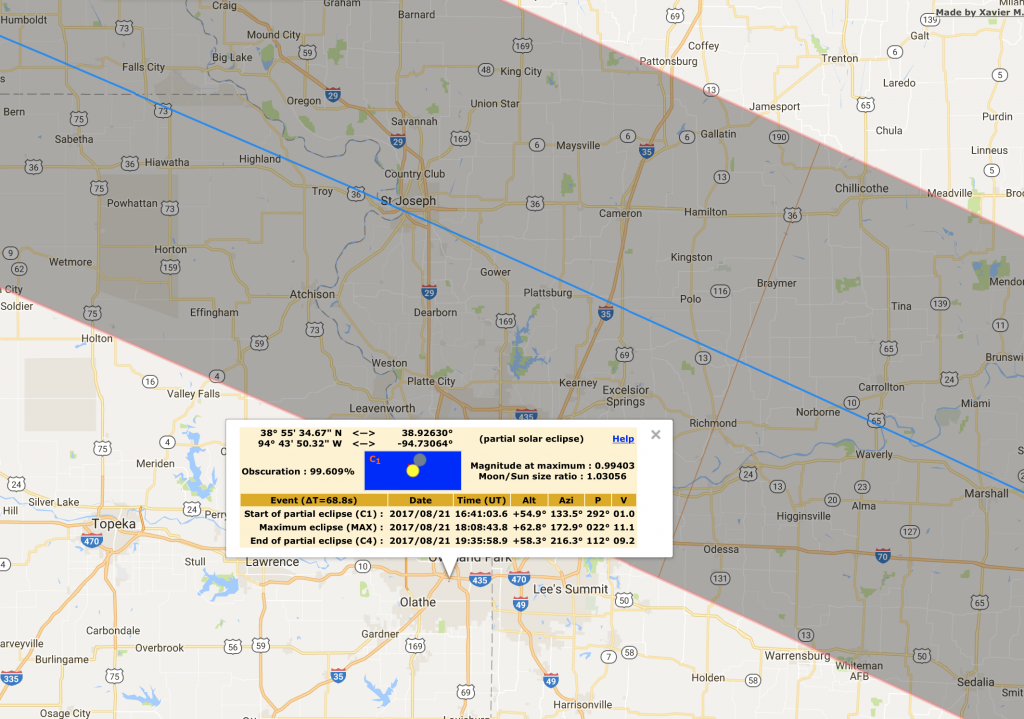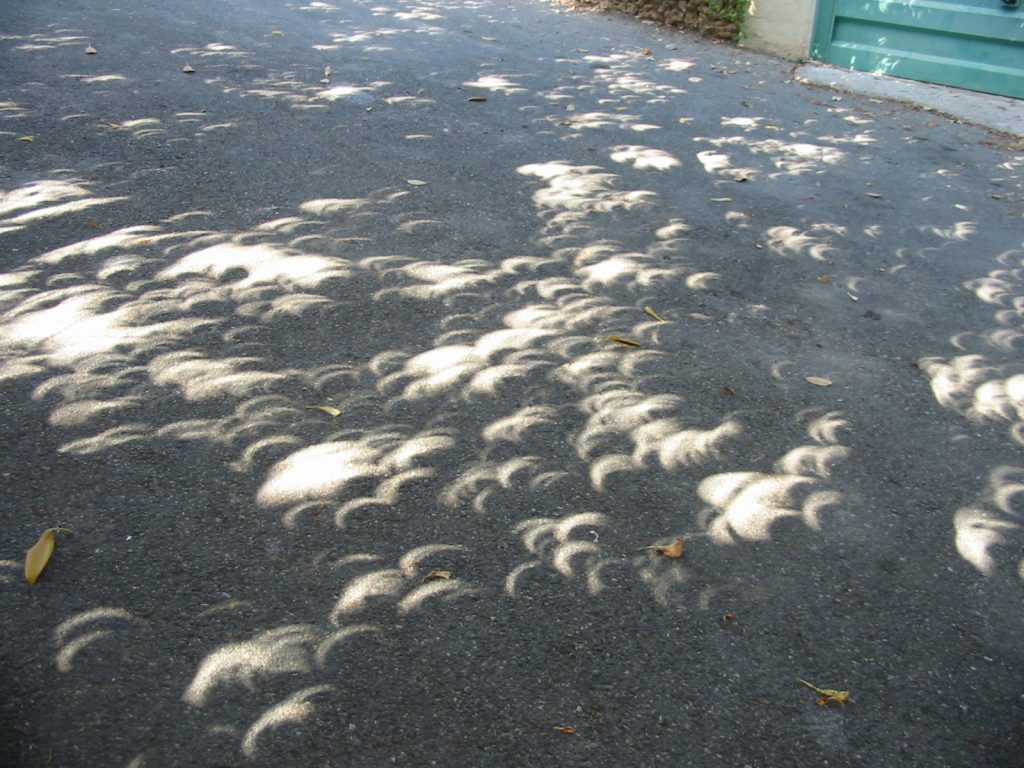On August 21, 2017, there will be a total eclipse of the Sun. The Moon’s shadow will be sweeping across the United States and very near Johnson County Community College. Unfortunately, the eclipse won’t appear completely total at the college, though pretty close (99.6% maximum coverage). The eclipse will be partial for about an hour-and-a-half. Straight north of Kansas City, the start of the partial eclipse (called “first contact“) will begin about 11:40am. Totality will begin (near the blue line) at 1:07pm and will last 2min 38.2sec. Times will vary some, depending on one’s exact location.

Even though the eclipse won’t be total at JCCC, there will be festivities celebrating the event. Starting at 11:30am, near “the hill”, there will be food, drinks and music. Solar glasses will be given away on a first-come-first-served basis. The CoLab is one location where you will be able to pick up a pair. The bookstore is selling eclipse t-shirts and will be selling solar glasses for $2.49 buyback hallway.
Members of the Astronomy Department will be along the path of totality observing and photographing the total eclipse. We urge students and members of the community to do the same, if possible. Here is a link to an interactive map that will give you data for other locations. Simply click on a location and the data will pop up. For those who can’t venture out, we will be attempting to live stream the event on the JCCC Youtube channel.
If you are at JCCC, it will look noticeably dimmer outside. If you are where it it total, you will see a lot more. There are features of the Sun that become visible when its bright surface (called the photosphere) is blocked. Look for solar prominences, hot gas magnetically suspended high above the Sun’s surface. They will appear a reddish in color. Look for a white fuzzy feature all the way around the disk of the Sun called the corona. The corona is the very hot upper atmosphere of the Sun. During totality you will also see stars and the planets Mars and Mercury. In fact, Mercury will be in a part of the sky that it is normally never seen! (To learn more about why that is, take one of our astronomy courses!)

On the ground, shadows will begin to look sharper. During the partial phase, you may see light that has passed through small openings, or passed between tree leaves, creating small images of the eclipsed Sun. Just before totality, on a light surface, such as the hood of a white car, you may see mysterious shadow bands, looking like the shadow of a flowing stream of cigar smoke. Nobody is really sure what causes this, though it is widely believed to be some kind of atmospheric phenomenon.
Don’t just see the eclipse, feel it! Some claim that witnessing a total solar eclipse changed their lives. Notice the emotions that such a spectacle and change in your surroundings invokes. What do you hear? What animals can you now hear and what animals can you no longer hear? Give a quick glance at people around you. Imagine the fear that people may have experienced before anyone understood what solar eclipses were about.
After that, take a moment to reflect on how, through science, we have come to understand what eclipses are and how to predict them. Science, and the quest to understand awesome spectacles of nature, is a human activity. As such, they can involve a variety of emotions. Get excited about science! We do!
As with any observing that has to do with the Sun, we want to stress safety and common sense! One should never look directly at the Sun without proper eye protection. Cameras and other optical equipment can also be damaged or destroyed if proper care isn’t taken. Because it is hard to tell by inspection whether solar glasses are accurately rated as proper eye protection, it is recommended that you obtain solar glasses only through reputable sources (JCCC, Astronomical Society of Kansas City, etc.) When proper solar glasses are worn, you should not be able to see anything but the Sun. More information about eye protection can be found on this NASA page.
To learn more about eclipses, planets, stars, black holes and the expanding universe, enroll in one of JCCC’s astronomy courses! JCCC offers:
- Astronomy (ASTR 122) with lecture, lab and evening observing sessions at the Paul Tebbe Observatory (4 credits, lecture and lab).
- Fundamentals of Astronomy (ASTR 120), which is a fully online course (3 credits, lecture).
Late-start 12-week, 8-week classes, and winter session online classes are available.